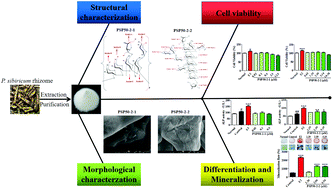Structural characterization and osteogenic activity in vitro of novel polysaccharides from the rhizome of Polygonatum sibiricum†
Abstract
Polygonatum sibiricum Red., a kind of edible and medicinal plant, has a long history of use in traditional Chinese medicine and as a nutritional food additive. Water-soluble crude polysaccharide (PS50) was obtained from P. sibiricum rhizome. After deproteinization and dialysis, PS50 was isolated and purified via DEAE-52 cellulose and Sephadex G-75 gel filtration chromatography to obtain two novel polysaccharides (PSP50-2-1 and PSP50-2-2). Chemical analysis and nuclear magnetic resonance (NMR) studies indicated that PSP50-2-1 was composed of β-D-Glcp-(1→, →2)-β-D-Galp-(1→, →2,6)-β-D-Galp-(1→, β-D-Fruf-(2→, and PSP50-2-2 was composed of β-D-Glcp-(1→, β-D-Galp-(1→, →2)-β-D-Galp-(1→, →6)-β-D-Galp-(1→, →2,6)-β-D-Galp-(1→, β-D-Fruf-(2→. The morphological analysis suggested that PSP50-2-1 and PSP50-2-2 both had a rough surface with cracks. Pharmacological studies showed that PSP50-2-2 at concentrations of 2.59 and 5.19 μM significantly promoted the differentiation and mineralization of MC3T3-E1 cells in vitro, which indicated that PSP50-2-2 had a function of osteogenic activity. Above all, this study provides evidence that PSP50-2-2 may be used as an anti-osteoporotic agent, with applications in health-care and pharmaceutical industries.



 Please wait while we load your content...
Please wait while we load your content...